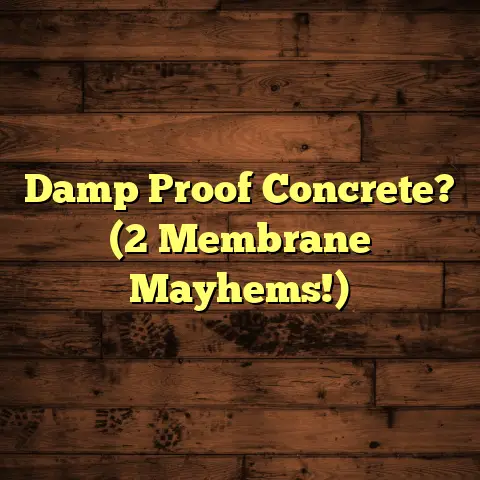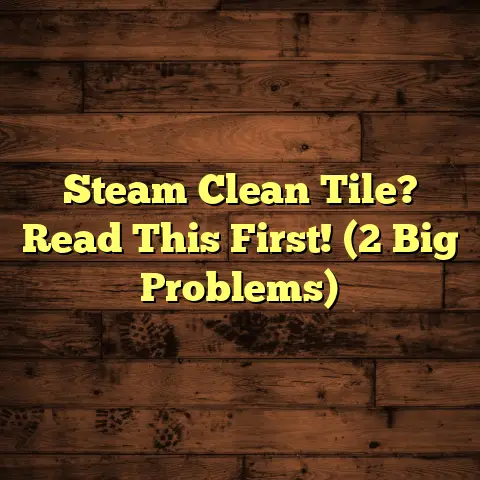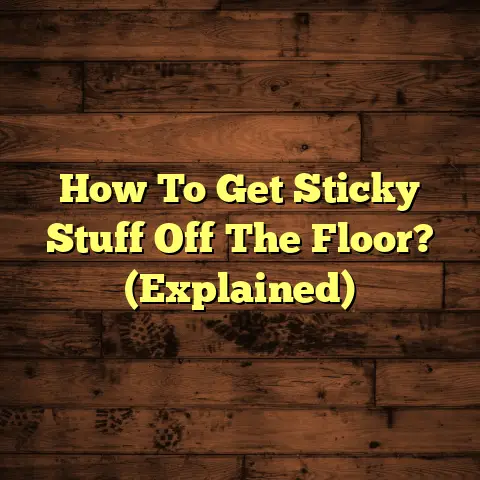How To Get Vinyl Floors Shiny?
I’m a flooring contractor, and believe me, I’ve seen it all when it comes to vinyl floors – the good, the bad, and the downright dull.
Vinyl flooring has exploded in popularity, and for good reason. It’s tough, budget-friendly, and comes in a mind-boggling array of styles.
But let’s face it: a vinyl floor that’s lost its luster is a real downer.
That’s why I’m here to share my insider knowledge on how to get your vinyl floors looking so shiny, you’ll practically need sunglasses!
1. Understanding Vinyl Flooring
So, what exactly is vinyl flooring?
At its core, vinyl is a synthetic material made from polyvinyl chloride (PVC).
It’s designed to mimic the look of natural materials like wood, stone, or ceramic tile, but with added benefits like water resistance and easy maintenance.
There are three main types you’ll encounter:
-
Sheet Vinyl: Comes in large rolls, offering seamless installation and excellent water resistance.
-
Vinyl Tile: Individual tiles that can be arranged in various patterns.
-
Luxury Vinyl (LV): The premium option, often thicker and more realistic-looking, available in planks (LVP) or tiles (LVT).
Vinyl flooring is a winner for several reasons:
-
Durability: It can withstand heavy foot traffic and resist scratches and dents.
-
Cost-Effectiveness: Generally more affordable than hardwood or tile.
-
Design Versatility: The possibilities are endless, with countless colors, patterns, and textures available.
2. The Importance of Shine
Alright, let’s talk shine!
Why is a shiny floor so desirable?
Well, for starters, it looks fantastic!
A gleaming floor instantly elevates the look of any room, making it appear cleaner, brighter, and more inviting.
Think about it: a dull floor can make even the most stylish furniture look lackluster.
A shiny floor, on the other hand, reflects light and creates a sense of spaciousness.
Beyond aesthetics, shine also contributes to the longevity of your vinyl floors.
A polished surface can act as a protective barrier, helping to resist scratches, stains, and wear.
3. Assessing Your Current Floor Condition
Before you grab your mop and polish, take a good hard look at your floors.
Are they just a little dull, or are they seriously worn?
Here are some telltale signs that your vinyl floor needs some TLC:
-
Lackluster Appearance: The floor looks flat and lifeless, with no reflective quality.
-
Visible Scratches: Fine scratches can accumulate over time, dulling the surface.
-
Stubborn Stains: Stains that won’t budge with regular cleaning.
-
Uneven Sheen: Some areas may be shinier than others, indicating uneven wear or cleaning.
What causes this dullness, anyway?
-
Dirt and Grime: Everyday dirt and grime build up over time.
-
Foot Traffic: Constant wear and tear from shoes.
-
Improper Cleaning: Using harsh chemicals or abrasive cleaners.
-
Lack of Protection: Failing to use mats and rugs in high-traffic areas.
4. Preparing for Cleaning and Maintenance
Okay, time to gather your arsenal of cleaning supplies!
Here’s what you’ll need:
-
Broom or Vacuum: For removing loose dirt and debris.
-
Mop: A microfiber mop is ideal for vinyl floors.
-
Buckets: One for clean water, one for your cleaning solution.
-
Vinyl Floor Cleaner: Choose a cleaner specifically designed for vinyl.
-
Floor Polish (Optional): For adding extra shine and protection.
-
Soft Cloths or Sponges: For tackling stubborn stains.
-
Safety Gear: Gloves to protect your hands.
Safety First!
Always read the labels on your cleaning products and follow the manufacturer’s instructions.
Ventilate the area well when using strong cleaners or polishes.
Now, let’s talk about creating a cleaning schedule.
How often you need to clean depends on how much foot traffic your floors get.
-
Daily: Sweep or vacuum to remove loose dirt.
-
Weekly: Mop with a vinyl floor cleaner.
-
Monthly (or as needed): Deep clean and polish.
5. Deep Cleaning Your Vinyl Floors
Alright, let’s get down to business!
Here’s my step-by-step guide to deep cleaning your vinyl floors:
-
Sweep or Vacuum: Remove all loose dirt, dust, and debris.
Pay special attention to corners and edges. 2. Prepare Your Cleaning Solution: Mix your chosen vinyl floor cleaner with warm water according to the product instructions.
-
Mop the Floor: Dip your mop into the cleaning solution, wring out the excess water, and mop the floor in overlapping strokes.
Rinse the mop frequently in the clean water bucket. 4. Tackle Stubborn Stains: For tough stains, apply a small amount of undiluted cleaner to a soft cloth or sponge and gently scrub the affected area.
Rinse with clean water. 5. Rinse the Floor (Optional): If your cleaner leaves a residue, rinse the floor with clean water and a clean mop.
-
Dry the Floor: Allow the floor to air dry completely, or use a clean, dry mop or cloth to speed up the process.
Recommended Cleaning Solutions:
-
Commercial Vinyl Floor Cleaners: Look for pH-neutral cleaners specifically designed for vinyl.
Brands like Armstrong and Bona offer excellent options. * DIY Cleaning Solution: Mix 1 cup of white vinegar with 1 gallon of warm water.
Vinegar is a natural disinfectant and helps to remove dirt and grime.
Important Note: Avoid using abrasive cleaners, scouring pads, or steel wool on vinyl floors, as they can scratch the surface.
6. Polishing Techniques for a High Shine
Okay, you’ve cleaned your floors – now it’s time to add that dazzling shine!
But what’s the difference between cleaning and polishing, anyway?
-
Cleaning: Removes dirt, grime, and stains from the surface.
-
Polishing: Adds a protective layer that enhances shine and protects against wear.
There are several types of products you can use to polish your vinyl floors:
-
Liquid Polish: Easy to apply and provides a good level of shine.
-
Wax: Offers a higher level of shine and protection but requires more maintenance.
-
Floor Finish: A durable coating that provides long-lasting shine and protection.
Here’s how to apply polish for maximum shine:
-
Choose the Right Product: Consider the type of vinyl flooring you have and the level of shine you desire.
Read product reviews and choose a polish that is specifically designed for vinyl floors. 2. Prepare the Floor: Make sure the floor is clean, dry, and free of any debris.
-
Apply the Polish: Pour a small amount of polish onto the floor and spread it evenly using a mop, applicator pad, or soft cloth.
Follow the manufacturer’s instructions for application. 4. Allow Proper Drying Time: Let the polish dry completely before walking on the floor.
Drying time can vary depending on the product, so be sure to check the label. 5. Apply Additional Coats (Optional): For a higher level of shine, apply a second or third coat of polish, allowing each coat to dry completely before applying the next.
7. Advanced Techniques for Long-Lasting Shine
Want to take your shine game to the next level?
Here are some advanced techniques I use on my projects:
-
Using a Floor Buffer: A floor buffer can help to achieve an even, high-gloss shine.
Use a soft buffing pad and work in overlapping strokes. * Applying Wax: Wax provides a durable, long-lasting shine, but it requires more maintenance than liquid polish.
Apply a thin, even coat of wax and buff to a shine. * Maintaining Shine Between Cleanings: Dust mop or sweep your floors daily to remove loose dirt and debris.
Use a damp mop with a pH-neutral cleaner to remove spills and stains as soon as they occur.
8. Preventive Maintenance for Vinyl Floors
The best way to keep your vinyl floors shiny is to prevent them from getting dull in the first place.
Here are some preventive maintenance tips:
-
Use Mats and Rugs: Place mats at entrances to trap dirt and debris.
Use rugs in high-traffic areas to protect the floor from wear and tear. * Trim Your Pets’ Nails: Long nails can scratch vinyl floors.
-
Use Furniture Pads: Place felt pads under furniture legs to prevent scratches and dents.
-
Avoid Harsh Chemicals: Use only cleaners that are specifically designed for vinyl floors.
-
Clean Up Spills Immediately: Wipe up spills as soon as they occur to prevent staining.
9. Troubleshooting Common Issues
Even with the best care, you may encounter some issues with your vinyl floors.
Here are some common problems and how to fix them:
-
Floors Lose Shine Quickly: This could be due to improper cleaning, using the wrong products, or excessive wear.
Try deep cleaning and polishing your floors more frequently. * Discoloration: Discoloration can be caused by sunlight, spills, or chemical reactions.
Try using a mild bleach solution to remove stains. * Scratches: Minor scratches can be buffed out with a soft cloth and a scratch repair kit.
For deeper scratches, you may need to replace the affected tile or plank.
When to Seek Professional Help:
If you’re dealing with severe damage, stubborn stains, or you’re simply not comfortable tackling the job yourself, it’s always best to call in a professional flooring contractor.
I’ve seen countless situations where a well-intentioned DIY attempt went sideways, resulting in more damage and expense.
Sometimes, the peace of mind that comes with knowing the job is done right is worth the investment.
10. Conclusion: Embracing the Shine
So, there you have it – my ultimate guide to achieving radiant, reflective vinyl floors!
We’ve covered everything from understanding vinyl flooring to deep cleaning, polishing, and preventive maintenance.
Remember, a little effort goes a long way when it comes to keeping your vinyl floors looking their best.
By following these tips and techniques, you can transform your dull, lifeless floors into a stunning showcase of beauty.
Don’t be afraid to experiment with different products and techniques to find what works best for you and your floors.
And most importantly, enjoy the process!
A shiny floor is a reflection of your hard work and dedication, and it’s sure to bring a smile to your face every time you walk into the room.
Happy shining!





